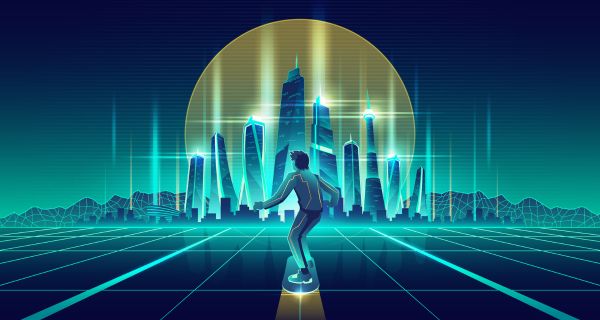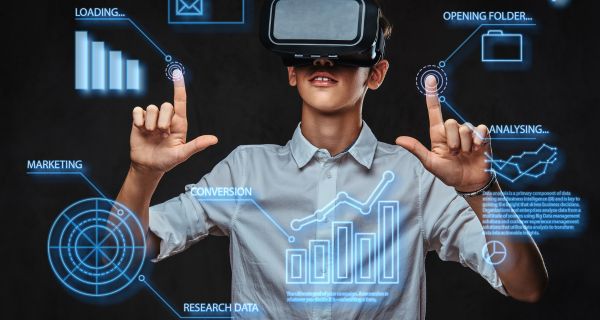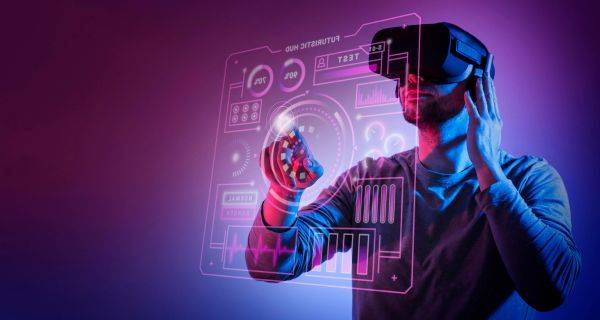The launch of Vision Pro and how Apple presented it as a spatial computing device looked like Apple just coined it. But it existed. With Apple and other companies emphasizing Spatial Computing to elevate user experience with headsets, it will likely see better adoption. So, stay put because this blog will discuss everything about Spatial it and how it relates to or differs from VR.
What is Spatial Computing?
Spatial Computing is the idea that adds virtual content to the physical environment. Digital objects appear in physical environments that people can see and interact with. It lets you create, change, and experience digital stuff concerning your surroundings. It is as if they are present in the space around you.
In simple words, it is the concept that combines the physical environment and virtual objects. Users can then be in the physical world and interact with those virtual objects.
When was the term “Spatial Computing” defined?
In 2023, Simon Greenworld defined the term as human interaction with computers where the machine-generated objects integrate into the real world and spaces along with real things, and humans can perform physical actions, pinch, and move head and body to give input. AR, VR, XR, computer vision, and AI are thriving today. In spatial Computing, all these work in beautiful synchronicity. It creates a different reality that makes it feel real.
You don’t have to interact with the hardware or any other device; that’s where AR/VR/MR and other features like AI and computer vision all play their important roles in helping you do everything with simple gestures like the movement of hands or your vision. But from the POV of technicalities, it’s more challenging than it seems. A huge amount of computation power and top-notch execution is needed to make it all happen while the user doesn’t feel any inconsistencies.
How does Spatial Computing work?
It is all about enabling a seamless interaction of its users with virtual objects and interfaces in the real-world environment. It uses software and hardware to make this interaction possible. For instance, the Apple Vision Pro uses premium hardware, software, and algorithms to sense things in real-time in the space its cameras and sensors capture. It then displays the content users can interact with.
Spatial Computing Examples
Spatial Computing applications expand across work, collaboration, utility, entertainment, and various sectors:
Education
Learning is fun and effective with interactive and engaging experiences that spark curiosity, creativity, and collaboration. For example, you can explore historical places or scientific phenomena and interact with their virtual recreation in the physical environment around you.
Entertainment
The entertainment industry is going to change forever. You can experience movies and shows as if they are happening before you. Isn’t that exciting? Imagine watching a football match and experiencing it much the same as anybody in the stadium. everything as someone in the stands but in a better way. Also, it will likely give a better experience than cinema when you sit on your couch with a headset.
Gaming

We all love playing games. Imagine being a part of those games you love, playing the characters in your favorite games, and roaming around the simulated fantasy worlds. When applied to games, Spatial Computing glasses will take it to another level, and more creative games will find their way into it. Games like Zelda, Genshin Impact, and other open-world games will no longer be a world on your screens. You will be able to live it.
Recreational Activity
Some people love to do activities like hiking, skiing, trekking, and more, but various reasons stop them from going to a convenient place to try them. But now, you can enjoy these activities with the help of Spatial Computers and enjoy them as you would in the physical world.
Healthcare
You will no longer have to visit hospitals to get a diagnosis. Your doctor can easily examine and interact with you and prescribe treatment and medicines. It is possible with an immersive video chat experience.
Retail
Have you ever wondered how great it would be to purchase furniture, clothes, and other things and view them as in the real world? With spatial computing, it will be possible soon. Retailers have to up their game, implement these techniques, and adapt to this changing way of shopping. It will be a bigger and much more widespread e-commerce experience.
Tourism
We all love traveling. But sometimes, because of financial limitations and other responsibilities, it’s not feasible to travel. But that could soon change with spatial Computing, powered headsets, and other gadgets. You can enjoy mountains and beaches from the comfort of your couch, and the costs will be a fraction of the original cost. As we progress, a complete experience of places worldwide could be a reality by wearing a small headset.
How will it Improving Life and Work?
Spatial Computing will make life easier with increasing adoption, and people will use it to improve work and enhance their experience at home, in the office, or while working remotely. Let us look at underlying concepts that come into play when we adopt it into our lives:
1. Matching computer programming and human perception of the world
It allows programmers to use natural concepts like location, distance, direction, and orientation to create applications that match how humans perceive and navigate the world. Now, they can use and process this information to create a copy of the world we call the physical world. It helps to create a world that can be straight from someone’s imagination.
2. Enables new physical workflows
Are you fascinated by the workflows as they show in sci-fi? That is going to turn into reality very soon. You can perform tasks and activities in physical space that were not possible or practical before. For example, workers see instructions or feedback on their field of view to train or collaborate in virtual environments.
3. Automates the process of creating digital twins
It automates the creation of digital twins, virtual replicas of physical objects or systems you can use for simulation, analysis, or optimization. For example, it can use computer vision and AI to scan and model physical assets or facilities in real-time and update them as they change.
4. Brings together robotic process automation and physical automation
You can program it such that it finds connections between robotic process automation (RPA), which uses software robots to automate repetitive tasks on digital platforms, and physical automation to control hardware objects in the real world. It can use computer vision and AI to coordinate and control multiple robots that can perform complex tasks in physical space.
5. Enables new ways of interacting between people, robots, and products in physical space
Video calls and meets are tools of the past. You can recreate the location of the participants and interact as you do in the real world. It enables new ways of interacting between people, robots, and products in physical space, enhancing communication, collaboration, and coordination. It can use MR to create shared spaces where people and robots can interact with each other and with digital content. Imagine Alexa or Google Assistant in physical form! That day is not far.
6. Help companies measure the performance of physical process variations

It can help companies measure the performance of physical process variations by providing data and insights on how different factors affect the outcomes. Again, using computer vision and AI, it can track and analyze how different layouts, designs, or workflows affect a physical process’s efficiency, quality, or safety.
7. Enables the orchestration of multiple physical processes
It can enable the orchestration of multiple physical processes by providing a unified platform that can monitor and control different aspects of a complex system. For instance, managing and optimizing the flow of materials, energy, or information across a supply chain or a smart city.
8. Improves the design of processes and objects
It can help create 3D spaces for projects that are too expensive to be made with flaws. In 3D space, you can try different scenarios, see each version’s flaws, and improve. It will help in solving a lot of architectural blunders that happen due to poor modeling.
How is the Spatial Computing technologies evolving?
In recent years, it has become more accessible and affordable with evolving hardware, software, and connectivity advancements. Today, we have smartphones, tablets, laptops, glasses, and headsets that allow us to experience stunning graphics and data. The sensors and cameras have also improved, enabling us to accurately capture and analyze our surroundings and movements.
Cloud and edge computing have given us greater storage and processing capabilities for spatial apps. With 5G networks and Wi-Fi 6 making their way, we can now enjoy faster and more reliable data transfer. Real-time interactions are seamless and with minimal delays. Also, AI has played a crucial role.
Apple Vision Pro and Spatial Computing
Apple Vision Pro is one of the most impressive examples of achieving that feat in spatial Computing. It is a standalone headset with an ultra-high-resolution display system. It packs 23 million pixels across two displays and custom Apple silicon in a unique dual-chip design to ensure everything the user sees feels real.
Vision Pro also features a breakthrough input system that uses the user’s eyes, hands, and voice to control the device without needing a dedicated controller. Users can access their favorite apps at any scale, enjoy stunning TV shows and movies, capture and relive memories, connect with others on FaceTime, and much more. The headset introduced a unique UI/UX for its new OS for Vision Pro. This OS completely differs from what you have ever used or interacted with so far.
The development needs for such technology with new features will be huge. Apple also launched a set of tools to help developers make special applications for its headset.
Adapting to this Changing World of Technology
If there is something that goes parallel with change, that is adaptation. Industries worldwide will have to adapt to the change brought up by spatial Computing sooner or later. It will change their operations and force them to upskill their workers similarly. Scalability and computation power were huge issues in the past, but Apple has found a way out, and soon the others will follow the course.
The obvious choice here is how fast you will choose to adopt. The sooner you do, the more likely you will make the best out of the benefits. While spatial computer costs are comparatively high, they will decrease with time and increase adoption. There is a lot of hype and expectation around the possibilities it opens in different sectors.
How will it Benefit?
Its benefits are commendable both at work and with entertainment. You no longer have to bury your head in cubicles and desktops. You can interact with people far away as they are with you and enjoy entertainment in a whole new way.
1. Supercharge your Work
The future of work and workspaces will likely change a lot. You no longer need to look at your computer screens or stroke your laptop keys for hours. You can multitask, navigate, and switch projects at your fingertips.
2. Navigate beyond the physical space
You can create and save different environments based on 3D mapping and no longer have to be limited to a particular landscape. All you need is to wear your headset, and you can navigate between different environments according to your mood. Are you a gamer? You can design an environment based on your favorite game. If you love nature, you can create a landscape design based on it. With spatial Computing, you will always be energized with how you live.
3. Say hello to gesture navigation!
Once you start using spatial computers, you don’t need any physical gear like keyboards, mouse headphones, etc. Gesture navigation is a new technology that helps you to navigate and work all through gestures and movements, like your eyes and fingers.
4. Take interaction to the next level
Have you ever been bored in a Zoom meeting? Well, that will change. With spatial headsets, you can create a meeting room and avatars similar to reality. It will completely change the interaction dynamics and increase the awareness often curbed down by the ordinary interface of different virtual meeting applications.
5. A New Way of Entertainment
Entertainment is way too immersive with spatial Computing. And with media companies like Disney supporting it on their platform, entertainment will be completely different from what we know now.
Future of Spatial Computing
Apple has paved the way for others, and some of the biggest challenges previously seen as obstacles have been crushed. The world is looking forward to a world of spatial Computing reaching its full potential. And if you are considering beginning your journey of immersive technology, look no further. With PlugXR, creators and brands have already succeeded in recreating their products and showrooms into simulated experiences that people can immerse themselves in and interact with for unmatching customer experience. Book a demo now to learn more about us.

